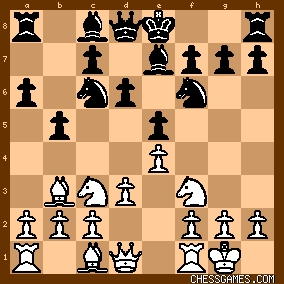| KEG: At the time of this replay of a Round 16 draw (which the Tournament Book says was played on March 8 and not March 1 as stated here), Teichmann was fighting for a high prize at this tournament. He was in third place at the time of this game, a quarter-point behind 2nd place Pillsbury and a quarter-point ahead of Janowski. Napier was out of prize contention, but--as he again proved later that year at Hanover 1902 where he had a winning record against the prize winners (defeating Pillsbury and Wolf in the process). At this tournament (Monte Carlo 1902), Napier had already won against Janowski, and in the penultimate round knocked off Tchigorin (preventing the Russian from getting at least a minor prize). This, Teichmann, though clearly the superior player, had to be careful with Napier. In the instant game, Napier went astray when he left his a-pawn hanging, perhaps believing (as is suggested in the Tournament Book) that he would be able to trap Teichmann's Bishop if it tried to grab a pawn). Teichmann, however, had seen further and deeper and was able to grab a pawn and remain ahead in material until the end of the game. Napier may not have been lost when he allowed Teichmann to steal his a-pawn, but he continued to misjudge the position and was clobbered by the alert Teichmann. Napier chose to play on even after he was hopelessly behind in material and utterly lost. Teichmann finished off the game with a pretty (but unnecessary) exchange sacrifice on move 38 that yielded him a bunch of additional pawns. At the end of the game, Teichmann was still down the exchange, but had FIVE pawns in return (all passed). After about move 24, the game was essentially decided. 1. e4 e5
2. Nf3 Nc6
3. Bb5 a6
4. Ba4 Nf6
5. 0-0 Be7
6. Nc3
A perfectly sound line for White that was popular in the early 20th century but has long since been out of fashion, 6. Re1 having become the usual move for White here. 6... b5
7. Bb3 d6
8. d3

click for larger viewA decent but quite passive continuation. The more usual move here is 8. Nd5. 8. a4 is another more ambitious idea for White. 8... Bg4
An off-beat line that Pillsbury had played against Napier at Buffalo 1901 in a game Pillsbury won. Teichmann may have known of that game, but I have no way of being sure. 9. Be3
The same weak move Teichmann played against Pillsbury. He should force Black to declare his intentions with 9. h3. For whatever reason, Napier delayed played h3 until move 15 here. 9... 0-0
Pillsbury played 9...Qd7 in the above-cited game against Napier. Given Napier's failure to play h3, Teichmann could simply have played 9...Na5 and later messed up White's Queen-side pawns with NxB. 10. Ne2
Another questionable choice by Napier. Once again, 10. h3 looks best. After the text, the position was: 
click for larger view10... d5
Still daring Napier to play 11. h3. Probably 10...Na5 was still the best course for Black. 11. Ng3 Qd7
12. c3
Now prepared for ...Na5, but still declining to chase the Black Bishop with 12. h3. 12... Rad8
13. Qe2 Rfe8
14. Rad1 h6
15. h3
Finally!
15... Be6

click for larger viewThus far, a cautious game by both sides seemingly played in slow motion. But, as will be seen, the action was soon to pick up. | 




